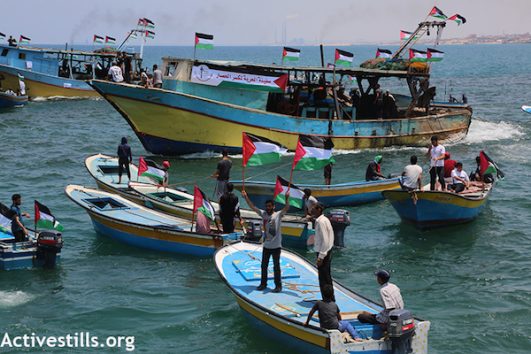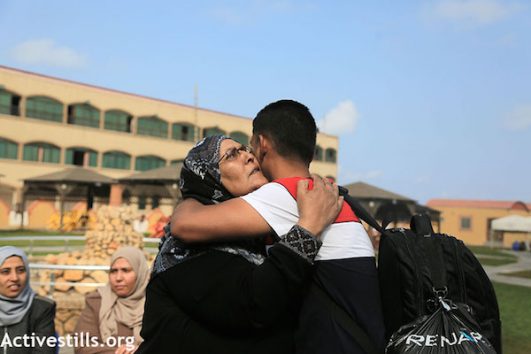Carrying 17 people, including university students, cancer patients, and protesters wounded by Israeli forces during the Great Return March, the Gaza boat was headed towards Cyprus before IDF gunboats intercepted it.
By Meron Rapoport, Mohammed Zaanoun, and +972 Magazine Staff

Israeli gunships intercepted a Palestinian boat attempting to break Israel’s naval siege of the Gaza Strip Tuesday afternoon. The attempt to break the blockade comes two weeks after Israeli soldiers killed at least 60 Palestinian protesters and wounded thousands of others at the Gaza-Israel separation barrier on Gaza’s eastern boundary.
The boat was headed to Limassol, Cyprus, and was part of a small flotilla comprised of three boats in total. The two other boats turned back and did not breach the naval blockade line enforced by the IDF. The IDF does not allow Palestinians to venture more than nine miles off the coast of the Gaza Strip.
The boat that the IDF intercepted was carrying 17 people. Those on board were mainly university students, but also included cancer patients and protesters wounded during the Return March seeking medical care outside of the besieged Gaza Strip, flotilla participants said.
“We are two university graduates, we lost hope of finding work in Gaza. Life in Gaza is impossible. We want a secure future. We are leaving for the sake of freedom,” flotilla participants Shadi al Nakleh, 28, and Ihab abu Armaneh, 29, told +972 correspondent Mohammed Zaanoun.
“We have no connection to any political party in Palestine,” the participants added. “We are sailing peacefully, without any weapons. Our message to the world is that we want peace — our journey is nonviolent.”
Asked about the risks their journey could entail, the participants responded, “We believe we will arrive in peace, but there are clear dangers: attack, arrest, the sinking the ship.”
“But the most important thing is that we will get their peacefully,” they stressed. “All other messages have failed.”
“Shadi told me that he wanted to leave, that he wanted to find work,” said Shadi’s mother. “He made his decision — what can I do? May God protect him from danger.”

After Israeli naval forces intercepted the boat, the IDF spokesperson announced that the boat would be towed to a naval base in Ashdod and the passengers returned to Gaza.
The interception of the Cyprus-bound boat comes just as another Freedom Flotilla, which departed the Norwegian port of Bergen on April 30, is on its way to Gaza. It is also nearly eight years to the day since Israeli commandos boarded the Mavi Marmara, part of the 2010 Gaza flotilla, and killed 10 Turkish activists.
Under the Oslo Accords, which created the system according to which the Israeli military rules Palestinians in Gaza and the West Bank, Israel agreed to allow Palestinian boats, and in particular fisherman, to operate freely in a zone extending 20 nautical miles off the Gaza coast.
The IDF, however, has not abided by that commitment for the past decade. Israeli authorities first shrunk the zone to 10 nautical miles, then three nautical miles. As part of a cease-fire agreement with Hamas after the 2014 Gaza war, however, Israel agreed to expand the zone to six nautical miles.
The size of the permitted fishing zone changes at the whim of Israeli military commanders and politicians, who have in the past openly discussed how they use it as collective punishment against civilians in response to rocket fire from armed groups. Sometimes Israeli naval forces simply announce via loudspeakers that they are reducing the size of the zone on a given day.
Israel’s decade-old siege on the Gaza Strip, reinforced by Egypt, is enforced through a military blockade on Gaza’s land and sea borders, full control of the Strip’s airspace and the destruction of its only airport. Despite the fact that Israel pulled its troops out of Gaza in 2005 the army still controls the Strip’s currency (the new Israeli shekel), the population registry, large parts of the electricity and water grids, all imports and exports, and decides who may enter and exit through the only regularly open passenger border crossing.
The IDF also controls movement inside the Gaza Strip. Israeli troops maintain a no-go zone several hundred meters from the Gaza-Israel separation barrier — the site of the 45-day-long Gaza Return March protests during which Israeli forces killed over 100 Palestinian demonstrators and wounded tens of thousands with live ammunition.
